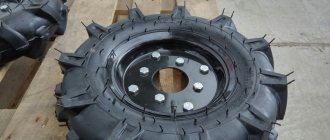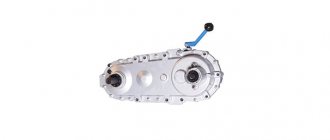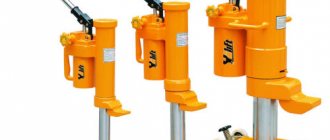What kind of oil should I put in my walk-behind tractor?
Many people ask the question “What kind of oil should I pour into a walk-behind tractor engine?” You need to start with the fact that the oil in the walk-behind tractor engine is poured directly into the crankcase and in no case is mixed with gasoline, as is the case with two-stroke engines, used mainly in chainsaws, trimmers, brush cutters, motor drills and other small motorized equipment. There is a special oil for two-stroke engines for this purpose .
Thus, the oil for a walk-behind tractor engine must be four-stroke, comply with GOST 10541-78, or API requirements: SF, SG, SH and SAE, type of walk-behind tractor engine oil: mineral 10W30, 15W30.
You can buy oil for a walk-behind tractor engine here
How to check the oil level in a walk-behind tractor? Checking the oil in the walk-behind tractor engine.
The oil level of any walk-behind tractor is checked by unscrewing the filler plug of the engine crankcase. The oil mark should be between the maximum and minimum marks on the dipstick. If there are no marks on the dipstick, it should be wetted approximately to the middle.
In the absence of the dipstick itself, after unscrewing the plug, the oil should be visible on the thread of the filler neck, into which, accordingly, the plug itself is screwed, that is, the oil should practically pour out a little more.
When to change the oil in a walk-behind tractor engine? Frequency of oil changes in the walk-behind tractor.
In a new walk-behind tractor engine, the oil must be changed after the first 5 (five) hours of operation, then after every 25 hours of operation, however, experienced walk-behind tractor owners change the engine oil every spring, before the start of the season, regardless of last year’s mileage, which in our opinion is the most optimal and correct.
Remember, any, even the most advanced walk-behind tractor engine, consumes at least 1 gram of oil per hour of operation (the so-called hourly oil consumption for waste), so you need to carefully monitor the oil level!
Is it possible to fill a walk-behind tractor with motor oil?
Timely replacement of oil in a walk-behind tractor is a very responsible and important job. After all, without this it is impossible to ensure high-quality and long-term operation of the main components and systems of the walk-behind tractor. The answer to the question: is it possible to fill a walk-behind tractor with motor oil and which one to choose?
The service life of the above-mentioned unit largely depends on the quality of the engine oil poured into the walk-behind tractor. It should be remembered that timely and correct replacement of engine oil is much cheaper than purchasing and installing new engine parts that have failed due to improper care.
Faulty compression
It may happen that the compression in the engine has dropped, then you should not make hasty decisions and go to repair it. You can do decoking, since in most cases, loss of compression and increased consumption occurs due to the engine becoming coked with carbon deposits or any unnecessary rubbish getting in there.
If this procedure does not bring results, then you need to repair the engine yourself or turn to professionals, it’s up to you to decide. However, before boring the cylinders and replacing the pistons, check the valve tightness and valve clearances. After everything has been checked and everything is normal, the first thing you need to do is change the oil piston rings and then bore the engine.
Why is car engine oil not suitable?
First of all, you need to follow the operating instructions for the walk-behind tractor and only on the basis of this document select the required brand and type of lubricant. In this article we will consider all the most important issues of replacing lubricating fluid in the main components of walk-behind tractors.
Many owners of walk-behind tractors wonder whether it is possible to use automobile engine oil to lubricate the main components of the unit. Experienced mechanics responsibly state that even if there is a sufficient amount of automobile fuel available, it is not recommended to use it for pouring into a walk-behind tractor.
The thing is that the engine of a car and a walk-behind tractor have different lubrication schemes and quite different operating temperature conditions.
In addition, the engines of a walk-behind tractor and a car differ from each other:
- Specific design
- Degree of boost
- Certain material
What types of lubricant should be used?
There are two types of lubricant for walk-behind tractors:
- For 4 stroke engine
- For 2 stroke engine
In this regard, it is necessary to fill exactly the type recommended by the manufacturer, taking into account the number of cycles of a certain brand of walk-behind tractor. In recent years, synthetic and semi-synthetic oils have become most widespread, ideal for use in walk-behind tractor engines. In specialized stores, the buyer is offered an assortment of various types of foreign and domestic production.
Changing engine oil in a walk-behind tractor
The process of changing the oil in a walk-behind tractor is quite simple and takes a short amount of time. For this work, you need to prepare in advance a container for draining used lubricating fluid with a wide neck and a set of keys of the required size.
The entire replacement process consists of the following work:
- The engine should be idled for 4-5 minutes so that the oil warms up and drains quickly;
- Carefully tilt the walk-behind tractor and use a key of a certain size to open the drain hole;
- The used oil completely flows out of the hole into a pre-prepared container;
- The drain hole closes;
- The filler hole opens;
- Carefully pour new oil into the filler hole;
- The filler hole closes securely.
After replacement, you need to check its level using a dipstick. The volume of the old drained and the new filled should be the same. It is very important to carry out the replacement at the same time as replacing the spark plugs.
Engine Maintenance
Most popular models have four-stroke engines running on gasoline, either domestic or foreign. Self-service walk-behind tractor maintenance includes:
- checking the oil level and quality (in the crankcase);
- monitoring the state of the ignition system.
Engine lubrication system
When choosing a class of motor oil, be guided by the manufacturer’s recommendations specified in the instructions not for the device itself, but for the engine. For the HONDA engine installed on Belarus walk-behind tractors, highly purified oil of SG, SF class according to API is suitable. The universal recommendation for viscosity level is SAE 10W-30 for any temperature.
Selection of oil viscosity according to ambient temperature (SAE classification)
How to measure the oil level:
- Turn off the engine and place it horizontally.
- Remove the oil sump cover*.
- Wipe the special dipstick and lower it into the neck.
- If necessary, add the recommended oil to the top of the neck.
*When changing the oil in a walk-behind tractor, after stage 2 you should perform several more operations:
- open the drain plug;
- drain the existing oil into a previously prepared container;
- then replace the plug and tighten it carefully;
- then continue to follow the instructions given. The oil change is carried out while the engine is still warm.
Holes for filling and draining engine oil of the SunGarden walk-behind tractor
Attention! Manufacturers warn that used motor oil is dangerous to the skin and can cause cancer. After contact with it, you should wash your hands thoroughly with soap.
Ignition system
Here, standard maintenance comes down to the fact that every season you must change the spark plugs. A problem with this system component is the most common reason why the engine will not start. Even simply cleaning the spark plug from carbon and dirt can resolve the situation.
Starting mechanism and ignition system of the Cascade MB6 walk-behind tractor: 1 - starter handle, 2 - fan housing, 3 - protective casing, 4 - cylinder, 5 - cylinder head, 6 - magneto, 7 - flywheel.
Sequencing:
- Remove the end of the center wire.
- Remove the spark plug by unscrewing it using a special wrench.
- Inspect carefully. The insulation should not crumble or crack.
- Clean the candle suitable for further use with a brush.
- Measure the gap. Adjust it to 0.7-0.8 mm. This is achieved by bending the side electrode.
- Check the condition of the washer.
- Reinstall the spark plug, following the thread pattern.
- Squeeze the washer and tighten it thoroughly with a wrench (the old spark plug another 1/4-1/8 turn, the new spark plug another ½ turn). An insufficiently pressed and carelessly installed spark plug will become very hot and may cause damage to the engine.
Important! For normal operation of the equipment, choose only spare parts recommended by the manufacturer or their analogues of the same thermal regime.
Oil in fuel mixture
For normal operation of 2-stroke engines, some oil will need to be added to the fuel, preparing the so-called fuel mixture.
4-stroke engines do not need such a mixture and are fueled only with clean fuel without adding oil. Diesel engines also do not need to add oil to gasoline, otherwise they can quickly break down.
The practical application of the above recommendations will allow timely replacement of the lubricant in the unit, which will thereby maintain its mechanism in a working position and significantly save money on its repair.
We hope our review - is it possible to pour car engine oil into a walk-behind tractor? Was useful to you. We ask you to leave your user reviews in the comments below about which lubricant you use.
Worn seals
Another question is if everything is fine with compression, but the car’s exhaust has a bluish tint, then in this case you need to check the seals, since the problem may lie in them and they should be replaced if necessary. But there are times when replacing oil seals does not bring results; this happens if the valve guides do not function.
Changing the oil in a walk-behind tractor engine
The working life of the engine of an agricultural unit depends not only on the quality of its components and assembly, but also on how correctly and how often you change the engine oil. By adhering to the manufacturer’s recommendations, you can extend the life of the unit and protect it from typical breakdowns.
To change the lubricant in a walk-behind tractor, you must first warm up the unit’s motor. To change the oil in a walk-behind tractor engine, you need to proceed in the following order:
- First install the unit in a horizontal position. The holes for filling and draining oil are always located on the left side of the walk-behind tractor engine. The remaining oil inside the engine must be drained through the drain hole, which is closed with a conical threaded plug. If the plug is twisted too tightly, you can unscrew it using a long screwdriver;
- Place a wide container with a volume of at least 2 liters under the drain hole and slowly unscrew the plug. Having finally removed it, wait 10 minutes until the lubricant is completely drained from the walk-behind tractor engine;
- After this, tighten the drain plug and start filling in new engine oil. It is best if you choose 10W40 synthetic or mineral based oil as your new formulation. Its volume should be equal to the amount of previously drained oil.
The lubricant in the walk-behind tractor engine should be changed at least once every 25–30 hours of operation. If you do not use the unit too often, and all work takes you about the same amount of time, then you can change the oil once a year. At the same time, remember that if you do not have time to work 30 hours per season, then the oil still needs to be changed, since during the time the walk-behind tractor is idle, the properties of the composition deteriorate noticeably.
If you have just purchased a walk-behind tractor, then you need to change the lubricant in its motor within the first 5 hours of operation of the unit. The fact is that after assembling new walk-behind tractors, small debris remaining inside the engine gets into the oil, which leads to engine jamming and minor breakdowns. In order for the engine of the new unit to be completely cleaned, the oil in it will need to be changed three more times - 2 times after 5 hours of operation, and the third time after 10 hours.
Engine system malfunctions during startup
If, when checking the spark plugs, they turn out to be wet, i.e. fuel flows normally, but the engine does not start, the problem may be the following:
If depressurization of connections is detected, it is necessary to tighten the mounting bolts, tighten the spark plugs and check the integrity of the gaskets between the spark plug heads and the cylinders.
To eliminate this problem, it is necessary to ensure free movement of the damper by monitoring the quality of the drive. If jams are detected, they must be eliminated.
Compression failure and carburetor problems
It happens that the launch is carried out, but the process is significantly difficult. At the same time, the engine of the walk-behind tractor is extremely unstable and cannot develop sufficient power for normal operation.
The reason for this may be loss of compression, which can be identified by:
In order to restore compression, you must:
If during engine operation black smoke comes out of the muffler, and excess oil is detected on the electrodes of the spark plugs or they themselves are covered with soot, this means that:
To resolve this issue you should:
If, when the engine is running, light smoke comes out of the muffler, and the electrodes of the spark plugs are dry and covered with a white coating, this means that a lean fuel mixture is entering the carburetor. This problem is eliminated by adjusting the carburetor.
Is it possible to fill a walk-behind tractor with motor oil?
This question is very relevant, especially among beginning farmers.
Many of them use automobile motor oil, believing that there is absolutely no difference between it and the composition for pouring into a walk-behind tractor engine. In fact, using car oil is a big mistake. The fact is that such a product does not have the characteristics that are necessary for the proper operation of the walk-behind tractor. The result of this is accelerated wear of the cylinders and piston group of the engine, which leads to breakdown of the walk-behind tractor and the need to completely replace its engine.
To prevent this, you should use specialized motor oil for a walk-behind tractor, the composition of which fully meets the requirements of an agricultural machine. To fill the engine, you can use 2-stroke or 4-stroke oil - it all depends on the type of engine of the walk-behind tractor.
The manufacturer of the lubricant is also of great importance - formulations from popular brands have proven themselves best in practice: Shell, Mobile, Castrol and Liqui Moly - they work equally well in engines manufactured by Briggs & Stratton, Subaru and other well-known companies. The third important factor is the seasonality of the motor oil - this characteristic determines at what temperatures the composition begins to lose its most important properties. In order not to make a mistake, we advise you to choose an oil for an all-season walk-behind tractor - it does not lose its characteristics at temperatures in the range from -25 to +40 °C.
Setting up the engine for the Oka walk-behind tractor
Auto mechanic, specializes in agricultural equipment
Many farmers and summer residents prefer the domestic Oka walk-behind tractor. The manufacturer of this unit is the Kaluga Motor Plant. Many people give their liking to the Oka because of its Russian production and assembly - the device is truly designed for the characteristics of our soils, thanks to which it copes with many different tasks on a plot of land. At the same time, its cost is quite affordable.
Lifan
In many farms and country houses you can find an Oka walk-behind tractor with a Lifan engine. The popularity of this modification is explained by the efficiency of the engine and good functional compatibility with small-sized equipment.
The engine also fits well on a walk-behind tractor. Lifan is a Chinese brand and is a large enterprise leading in its production segment. The engines of this company have earned a reputation as reliable devices with a long service life. Therefore, if the farm uses motorized cultivators, which engine to install on them when replacing it, you can decide by carefully studying the characteristics of the engine.
When choosing, priority attention should be paid to the goals that the equipment faces:
- what is the area of the land plot;
- what tasks should the unit perform (cultivating land, planting, hilling and digging up potatoes, watering, cleaning the site, transporting goods, etc.).
Is it necessary to add oil to gasoline for a walk-behind tractor?
To find out whether it is necessary to dilute gasoline for a walk-behind tractor, you need to study the instructions for its use.
It indicates what type of engine the unit is equipped with - 2-stroke or 4-stroke. If the walk-behind tractor is equipped with a 2-stroke engine, then the fuel mixture for it must necessarily consist of gasoline and oil. When preparing the mixture, follow the exact proportions specified by the manufacturer in the instruction manual. At the same time, fuel for a walk-behind tractor with a 4-stroke engine does not need to be mixed with oil, since all 4 strokes of such engines run on pure fuel.
It should be remembered that walk-behind tractors into which diesel is poured also do not require preparation of the fuel mixture. The fact is that all diesel engines are 4-stroke engines and run on clean fuel.
Fuel supply problems
If attempts to start the walk-behind tractor are unsuccessful, this means there is a malfunction in the engine or starting system. In order to determine the source of the breakdown, you first need to check the spark plugs.
If the spark plugs are dry, this means that the fuel mixture is not entering the engine cylinders. There may be several reasons for this:
To resolve fuel supply problems, you must:
If fuel enters the carburetor but does not reach the cylinder, the problem is in the carburetor itself. To eliminate it, this unit must be removed, disassembled and cleaned. Well, after that - assemble and install in place. Therefore, before performing all the necessary manipulations, it will not hurt to refresh your memory of the structure and principle of operation of the carburetor.
Oil for a diesel walk-behind tractor - features of choice
When choosing engine oil for a diesel walk-behind tractor, you should follow the instructions in the operating instructions.
However, if the instructions for use have been lost, then you will have to study the compositions available on the market more carefully. Motor oils for diesel engines are classified into the following categories. The special markings indicated on the container with lubricant will help determine the type and compliance of the composition for a particular walk-behind tractor:
- API CJ-4 - compounds with this marking are designed specifically for walk-behind tractors with a capacity of 10 hp or more. With. and more. The composition of these lubricants has increased viscosity, which guarantees the proper operation of all elements of the unit’s motor;
- API CI-4 - these oils should be used for engines equipped with different types of injection and supercharging. Such oils have good dispersing characteristics and high resistance to thermal oxidation;
- API CH-4 - lubricants with this marking fully comply with all modern requirements and quality standards. Among the advantages of these compositions, one should highlight the ability to fill them into diesel engines running on fuel in which the sulfur percentage exceeds 0.5%;
- API CA - compositions of this type are optimally suited in cases where diesel fuel contains a small amount of sulfur. Oils with this marking protect the walk-behind tractor engine from the formation of harmful deposits on its walls;
- API CB - the use of oils of this oil reduces the risk of corrosion of walk-behind tractor bearings;
- API CC - such oils will be the best option for an engine equipped with a turbocharger, but without a supercharger. These compounds help walk-behind tractors withstand long-term loads and work properly in difficult conditions;
- API CF-2 - oils of this group perform well when used in walk-behind tractors that are subject to heavy loads.
After purchasing suitable motor oil, you can proceed to pouring it into the walk-behind tractor engine. The procedure for this is quite simple:
- First install the unit in a horizontal position;
- Place a wide container under the drain hole in the engine and remove the plug by carefully prying it off with a screwdriver;
- Wait until the old oil drains from the engine and screw the plug back into the hole;
- Pour at least 2 liters of new lubricant inside the engine.
Remember that the oil in new walk-behind tractors should be changed three times at intervals of 5 hours of moderate use. After this, replacement is required no more than once every 25 hours of operation of the walk-behind tractor.
How much to fill
Most walk-behind tractors presented on the Russian market are equipped with engines from the HondaGX family, their Chinese clones, or Subaru-Robin engines of a similar design.
For a one-time full filling of such an engine with oil, no more than 0.6 liters of oil will be required - which is why this packaging volume is popular among manufacturers. More powerful modifications of these engines can hold a liter or more of oil.
A number of engines, the design of which includes an additional reduction gearbox, have a separate space for its lubrication.
Table of filling volumes for original Honda engines (Honda) and similar Chinese ones
| Model | Oil volume |
| HONDA GX-100 | 0.4 l |
| HONDA GX-120, GX-160, GX-200 | 0.6 l |
| HONDA GX-240, GX-270, GX-340, GX-390 | 1.1 l |
Subaru engines
| Model | Oil volume |
| EH34B | 1.1 l |
| EH34D, EH41D, EX35D | 1.2 l |
| EX13D, EX17D, EX21D | 0.6 l |
| EX27D | 1 l |
If your walk-behind tractor is equipped with a Briggs&Stratton engine
| Model | Oil volume |
| I/C® 3.5 HP, 5 HP, 6.5 HP | 0.6 l |
| I/C® 8.0 HP, 10 HP, 13.5 HP | 1.1 l |
Oil in the gearbox of a walk-behind tractor - how to check and change?
The gearbox is an important element of the walk-behind tractor, the function of which is to transmit torque from the motor to the wheels of the unit via a V-belt drive.
Gearbox parts are subject to increased wear and therefore require regular lubrication. Let us immediately make a reservation that not all products available on the market are suitable for this purpose. The best option for lubricating the gearbox is gear oil. This type of compound is excellent for lubricating moving parts. The second important question is how much lubricant should be poured into the gearbox. To find out, you will need to perform a number of specific actions:
- Carefully place the walk-behind tractor so that its wings are parallel to the surface;
- Take a wire at least 70 cm long and bend one of its sides into an arc;
- Insert the wire through the filler hole until it stops, then pull it back out.
Next, look at the wire. If its wet side is 30 cm, then there is no need to add oil to the gearbox. If the lubricant level is lower, then you will need to add as much oil as required to reach the 30 cm mark on the wire. Lubricant must be poured into the gearbox in the following order:
- Place the walk-behind tractor on stands;
- Under the walk-behind tractor at the bottom of the gearbox, find the drain plug. Place a wide container under it and slowly unscrew the lid;
- Wait 10 minutes, during which all the oil will drain from the gearbox;
- Screw the drain cap all the way, unscrew the filler plug and place a funnel in it;
- Fill the gearbox with approximately 2 liters of transmission oil;
- Check the level of the composition using a wire - if there is less than 30 cm of wire in the oil, then add a little more material.
In most cases, it is necessary to change the lubricant in the gearbox of a walk-behind tractor at least once every 100 hours of operation of the unit. In this case, the frequency of replacement may vary depending on the recommendations of the walk-behind tractor manufacturer. If you use your agricultural machine for more than 4 hours a day, then you need to replace the composition once every 50 hours of operation of the walk-behind tractor.
Device
The gearbox is a special device included in the design of any walk-behind tractor. It is this part that is responsible for converting and transmitting torque that is generated from mechanical transmissions. In fact, the gearbox powers the walk-behind tractor, making it work.
The service life of the entire walk-behind tractor, as well as its normal functioning, will depend on its quality, as well as on the correct lubrication of its components.
For more details about the gearbox, watch the video:
Depending on the model of the walk-behind tractor, be it Cayman, Patriot Ural, Patriot, Texas, Foreman or some other, the gearboxes may differ from each other in some design features. Conventionally, gearboxes can be divided into several types:
- Angular reducers. Such units are quite effective and allow you to couple the engine and transmission.
- Gear reducers. In this case, the gearbox transmission acts as a kind of intermediary between the engine and the wheelbase of the walk-behind tractor.
- Reduction gearboxes. These units achieve an increase in power indicators by reducing the total number of revolutions. Such gearboxes are most preferable because their design includes an air cooling system, which allows them to operate at maximum loads.
- Reverse gearboxes. The main advantage of such gearboxes is the ability to reverse the walk-behind tractor. However, units equipped with this type of gearbox do not show high performance indicators and speeds.
Regardless of which gearbox is used in the design of the walk-behind tractor, they all consist of almost the same components:
- shaft;
- gear housing;
- flange and its fastening;
- pulley with V-belt drive (or chain);
- ball bearing;
- stars;
- drain plug;
- steel washer and nut;
- input shaft
These components traditionally form the gearbox itself. and service life will depend on how well they are
Otherwise, if there is insufficient lubrication, the parts will wear out greatly, because they come into contact with each other during operation, and the resulting friction negatively affects their surface.
Transmission oil for walk-behind tractor
When choosing gear oil, the first thing you should pay attention to is the recommendations of the walk-behind tractor manufacturer. Each of the brands involved in the manufacture of agricultural machinery uses mechanisms that are different in design. Accordingly, the latter require oils of different composition. To avoid mistakes when choosing gear oil, we advise you to study the table, which contains recommendations from the most well-known manufacturers of walk-behind tractors.











